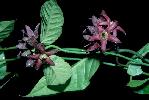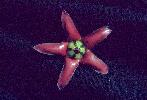Species profile—Marsdenia hemiptera (rusty vine)
Classification
Plantae (plants) → Equisetopsida (land plants) → Apocynaceae → Marsdenia hemiptera (rusty vine)

Go to Photo gallery
Sighting data
Species details
- Kingdom
- Plantae (plants)
- Class
- Equisetopsida (land plants)
- Family
- Apocynaceae
- Scientific name
- Marsdenia hemiptera Rchb.
- Common name
- rusty vine
- WildNet taxon ID
- 11211
- Superseded by
- Leichhardtia racemosa (04/06/2021)
- Alternate name(s)
- thozetia
- Conservation significant
- No
- Confidential
- No
- Endemicity
- Exotic
- Pest status
- Nil
- Description
- Marsdenia hemiptera is a pubescent woody vine with clear or slightly green-yellow latex. The roots are fibrous. The indumentum is ginger-orange. The stems are cylindrical, up to 7 mm in diameter, with sparse to dense trichomes when young, usually becoming corky with age. The internodes are up to 17 cm long. The leaves are petiolate. The lamina is lanceolate-ovate to ovate-elliptic, up to 19 cm long and 11 cm wide, and discolorous. The upper lamina surface is green, with scattered to sparse trichomes, and obscure venation; the lower surface is pale green with scattered to dense trichomes and prominent venation. The tip is acuminate; the base cordate; the petiole grooved along the top, up to 3.5 cm long and 1 to 2 mm in diameter. There are 8 to 13 colleters at the lamina base. The inflorescences are racemose, up to 5 cm long. The peduncle is up to 5cm long and 2 to 3 mm in diameter, with scattered to dense trichomes. The sepals are lanceolate, 3 to 6 mm long by 1.5 to 4 mm wide, with sparse to dense trichomes externally. The corolla can be red, red-purple or pale pink-cream; the tube measures up to 4 mm long by 8 to 10 mm in diameter, they have lanceolate shaped lobes 8 to 14 mm long by 2 to 7 mm wide. Corolline corona absent. Staminal corona green to cream, 4 to 6 mm long by 4 to 7 mm in diameter. The anther appendages is ovate to obtuse. Style-head green, conical-depressed to conical-elongate. The fruit is spindle to egg-shaped and up to 10 cm long by 2.5 cm wide. Each fruit has a hooked tip, and contains many ovate seeds 7 to 8 mm long by 6 to 6.3 mm wide (Forster, 1995; Forster, 1996; Wang, 1997).
Marsdenia hemiptera is distinctive with its ginger-orange coloured indumentum and the clear to green latex in the foliage (Forster, 1996). - Distribution
- Marsdenia hemiptera is widely distributed, but infrequent, occurring from Brunswick Heads, New South Wales to the tip of Cape York Peninsula in Queensland, and in northern Northern Territory and the Kimberly region in Western Australia. The species occurs in Daintree National Park (NP) Deepwater NP; Monduran State Forest; Noosa NP; Moogerah NP; Deer Reserve NR; Mt Grevillea NP; Wilkie Scrub Conservation Park, Brunswick Heads Nature Reserve (Queensland Herbarium, 2011)
- Distributional limits
- -10.7340604, 142.4663888
-28.0797932, 153.3035699 - Range derivation
- Range derived from extent of the taxon's verified records
- Habitat
- In Queensland Marsdenia hemiptera has been found between altitudes of 20 and 480 m asl. The species occurs on chocolate soils, red-brown gravelly loam derived from basic volcanics and sandy loam soil. The plant is found in notophyll vine forest communities in gorges or low lying areas where water is present most of the year. Associated species include Alstonia muelleriana, Syzygium forte, Flindersia bourjotiana, Chrysophyllum roxburghii, Argyrodendron polyandrum, Arytera divaricata, Alangium villosum, Aglaia brownii, Pseudoweinmannia lachnocarpa, Geissois benthamii, Sloanea woollsii, Medicosma cunninghamii and Baloghia inophylla (Queensland Herbarium, 2011).
- Behaviour
- Data recorded on the Tropical Fire Responses Database (Gardener and Marrinan 2004) note the life span of the species is greater than 20 years; the species first seeds 6-20 years; the species is a basal resprouter.
- Reproduction
- Flowering of Marsdenia hemiptera occurs from November to March, with fruiting three to four months later (Wang, 1997; Queensland Herbarium, 2011).
- Threatening processes
- There are no substantial threatening processes to Marsdenia hemiptera which have been identified in the literature. Previous threats have included timber harvesting and clearing of rainforest, but this is now prohibited (Wang, 1997).
- Status notes
- Although Marsdenia hemiptera has a relatively wide distribution, it is not common in any location (Wang, 1997).
Marsdenia coronata is listed as Near Threatened under the Queensland Nature Conservation Act 1992. - Management documents
- Wang, J. (1997) Marsdenia hemiptera Species Management Profile, Department of Natural Resources, Queensland.
- Management recommendations
- Management objectives for the protection of Marsdenia hemiptera and its habitat include the establishment of a protective buffer (0.25 ha) that excludes clearing in areas where the species occurs (Wang, 1997).
- Notes
- Occurs in the following Queensland pastoral districts: Cook, Moreton, Port Curtis, Wide Bay. Also occurs in the following regions: Northern Territory and New South Wales (Bostock and Holland, 2010).
- References
- Bostock, P.D. and Holland, A.E. (eds) (2010). Census of the Queensland Flora 2010. Queensland Herbarium, Department of Environment and Resource Management, Brisbane.
Forster, P.I. (1995). Circumscription of Marsdenia (Asclepiadaceae: Marsdenieae), with a revision of the genus in Australia and Papuasia. Australian Systematic Botany 8 (5): 726.
Forster, P.I. in Orchard, A.E. (Ed) (1996). Flora of Australia 28: 257.
Gardener, M. and Marrinan, M. (2004). Tropical Savannas Fire Response Database. Accessed 22/12/2011. http://www.landmanager.org.au/fire-responses-marsdenia-hemiptera.
Queensland Herbarium (2011). Specimen label information. Queensland Herbarium. Accessed 21/07/2011.
Wang, J. (1997). Marsdenia hemiptera Species Management Profile. Department of Natural Resources, Brisbane. - Profile author
- Lynise Wearne (25/06/2012)
Other resources
Data source
This profile data is sourced from the QLD Wildlife Data API using the Get species by ID function used under CC-By 4.0.
https://apps.des.qld.gov.au/species/?op=getspeciesbyid&taxonid=11211.
This information is sourced from the WildNet database managed by the Queensland Department of Environment and Science.



